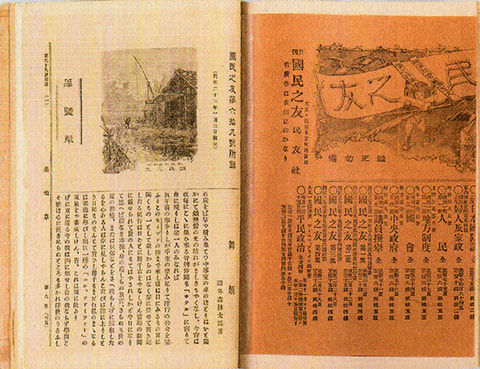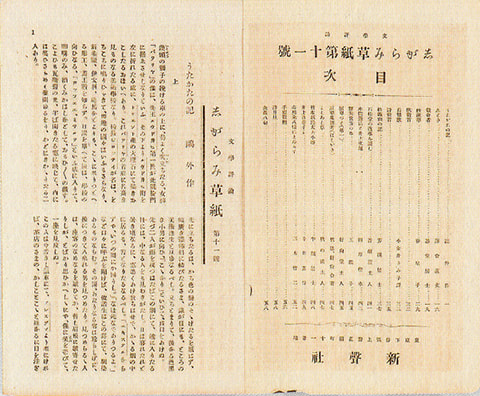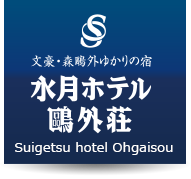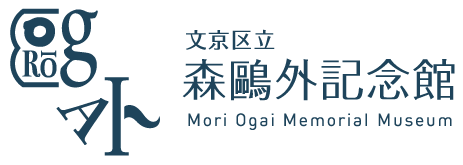
Ogai Mori (Owned by the National Diet Library)
Taken in 1961 at a studio of Kozaburo Takeishi, a sculptor
Ogai Mori (Rintaro Mori, 1862-1922) is a great literary figure of the Meiji Period. He was born into a family line of doctors, and vigorously engaged in literary activities in the fields of novels, translation, dramas and critiques while working as an army doctor.
Ogai returned to Japan after studying in Germany, and brought knowledge based on Western values into Japanese literature in the Meiji Period, in which Western ethos overwhelmed Japanese literary circles, and new literature was groped for. He laid a foundation of Japanese modern literature in the 1880s which was called the age of "Ko-Ro-Sho-Oh," that is, Koyo Ozaki, Rohan Koda, Shoyo Tsubouchi and Ogai Mori, all of whom were very active at that time.
Ogai Mori (his autonym is Rintaro Mori) was born at the end of the Edo Period (the age was about to change dramatically from the Edo to Meiji Periods), that is in 1862, as the eldest son of the Mori family that had been doctors for the Tsuwano domain (Shimane Prefecture). Ogai entered "Yorokan," a domain school, at the age of seven, and later went to Tokyo at the age of 10 with his father, following wishes of the Kamei family, a feudal lord. Although he enrolled in a premedical course of the Faculty of Medicine, University of Tokyo, in the next year at the age of 11, he lied about his age because the course did not accept students below the age of 13.
Young Ogai maintained excellent academic records, aiming to study in Germany, which was to be sponsored by the government, and become a scholar. However, he met with misfortune, such as getting out of condition when taking a graduation examination, and could not realize his dream of becoming a government-sponsored student. Therefore, he started his career as an army doctor, receiving advice from those around him.

Lecture note handwritten by Ogai (Reproduction, Owned by Bunkyo City Mori Ogai Memorial Museum)
Ogai meticulously took notes on medical lectures, completing several courses, including zoology, botany and pathology.

Ogai studied the hygiene system of the Kingdom of Prussia, and compiled it as "Igaku Zensho Kohon," a complete medical book, while pursuing his studies as an army doctor. Since his achievements were evaluated, he went to Germany as a government-sponsored student to investigate and research hygienics. He visited Leipzig, Dresden, Munich and Berlin. He wrote a diary titled "Doitsu Nikki" about his four years of experience studying in Germany. We can know his early days from the diary, in which he associated with many people and enjoyed culture and art while carrying out researches.

Ogai returned to Japan in 1888, and published "Omokage," a collection of translated poems, in 1889. He also launched "Shigarami-zoshi," a predecessor of "Mesamashi-gusa," a literary magazine, and wrote "Maihime," or dancing girl, which was his first novel, at Ogaisou (the present Suigetsu Hotel). In this way, he started to engage in two trades at the same time: an army doctor and a writer. His studying in Germany significantly affected his literary activities, and "Maihime," "Utakatano-ki" and "Fumizukai," which are called "Germany Trilogy," had their settings in Berlin, Munich and Dresden, respectively. Those novels written in an elegant style noticeably reflected his experiences in Germany, and evoked massive responses in the literary circles.



Germany Trilogy (Owned by Bunkyo City Mori Ogai Memorial Museum)
Left "Maihime" ("Kokumin-no Tomo," issue 69), Center "Utakatano-ki" ("Shigarami-zoshi," issue 11), Right "Fumizukai" ("Shincho Hyakushu," issue 12)
As for his private life, Ogai got married with Toshiko, the eldest daughter of Baron Akamatsu, a vice admiral, in 1889, and had a baby next year. However, he divorced his wife soon for some reasons, and left Ogaisou. In the course of time, the Sino-Japanese War (1894-1895) began, and he joined the army as an army doctor.
He returned to Japan in 1895, and immediately started "Mesamashi-gusa," a literary magazine. Famous writers at that time, including Rohan Koda, Koyo Ozaki and Ryokuu Saito, wrote for the first issue, and the magazine received great acclaim.
However, Ogai had to work in Kokura, Kitakyushu City, so his literary activities were restricted, and later "Mesamashi-gusa" discontinued. Although he had to leave Tokyo, a hub of literature, against his will, and could not write a novel after the publication of the Germany Trilogy, he made an effort to do translation and criticism, and translated "The Improvisatore," a novel by Hans Andersen, which was published later.
He remarried Shige Araki in 1902, and went to Tokyo. However, the Russo-Japanese War (1904-1905) began two years later, that is in 1904, and he went to the front again. He composed tanka and haiku poems, and sent those poems to his family and friends to keep in touch with them. Those poems were later compiled as "Uta Nikki" with cooperation of Kyoshi Takahama and Nobutsuna Sasaki.


Although Ogai got back into the literary world after returning to Japan in 1906, Koyo, Ryokuu, and Shiki Masaoka who Ogai fraternized with through "Mesamashi-gusa" had already died. While the naturalist literature advocated by Toson Shimazaki, Katai Tayama and others appeared on the scene, Takuboku Ishikawa, Mokutaro Kinoshita and Isamu Yoshii looked up to Ogai as their mentor, and started "Subaru," a magazine. Ogai wrote important novels one after another, such as "Vita Sexualis" (1909), "Seinen," or adolescent, (1910), and "Gan," or wild goose, (1911), for the magazine.
Ogai also had a profound knowledge of the Western art history. A character modeled after Naojiro Harada, who Ogai got acquainted with while studying in Germany, appeared in his novel "Utakatano-ki," and we can know through its descriptions that Ogai was fond of seeing art works in Germany. Ogai worked as a lecturer of art anatomy at the invitation of Tenshi Okakura, who was the principal of Tokyo Fine Arts School at that time, after returning from Germany in 1891. Ogai's art criticisms and abridged translations of aesthetics texts frequently appeared in "Mesamashi-gusa," while descriptions of Western paintings were seen several times in his novels. He likened a girl's face to "Nana" by Édouard Manet in his novel "Seinen," and mentioned "Rain, Steam and Speed – The Great Western Railway" by William Turner when he saw a car (rare in those days) parked in front of Ueno Seiyoken. He also compared beauty of a woman to "Mona Lisa" by Leonardo da Vinci. Since he had such a profound knowledge of the Western art, he was appointed an examiner for the Western-style painting section of the first Bunten exhibition (the art exhibition sponsored by the Ministry of Education) in 1907, and became the first director of "Teikoku Bijutsuin," or the Imperial Fine Arts Academy, in his later days, that is in 1919.
He also published historical novels, including "Abe Ichizoku," or Abe family, and "Sansho Dayu," or Sansho the Bailiff, in 1910s. He left the army for which he had served for 35 years in 1916, and became the president and director general of Imperial Museum (the present Tokyo National Museum) in 1917. He led a busy life until just before he died at the age of 60 in 1922.

"Mesamashi-gusa," vol. 1 (Owned by Bunkyo City Mori Ogai Memorial Museum)
A literary magazine edited by Ogai Mori. The vol. 1's cover was designed by Naojiro Harada, a painter, who Ogai kept company with when studying in Germany. Famous writers, including Rohan Koda, Koyo Ozaki and Ryokuu Saito, wrote extensively for it. "San-nin Jogo," a joint review by Ogai, Ryokuu and Rohan, (later retitled "Unchugo") attracted attention as a literary criticism. Besides Naojiro Harada, Fusetsu Nakamura and Seiki Kuroda also designed the covers.

"Subaru," vol. 1 (Owned by Bunkyo City Mori Ogai Memorial Museum)
This magazine was started by young writers who left "Tokyo Shinshi-sha" founded by Tekkan Yosano.

This book summarizes Ästhetische Zeitfragen written by Johannes Volkelt, a German philosopher.

Tomb of Rintaro Mori (Zenrinji Temple)

"Testament written by Tsurudo Kako" (Reproduction, Owned by Bunkyo City Mori Ogai Memorial Museum)
Ogai's testament was written by Tsurudo Kako, his best friend, three days before his death because he was too weak to write by himself. Although Ogai accomplished great achievements as an army doctor and a writer, he said at his death, "I want to die as Rintaro Mori. Never engrave a single character other than 'Tomb of Rintaro Mori' on the tombstone." Just the Chinese characters, meaning "Tomb of Rintaro Mori," written by Fusetsu Nakamura, a friend of Ogai, are engraved on his tombstones placed on cemetery lots in Zenrinji Temple (Mitaka City, Tokyo) and Yomeiji Temple (part of Ogai's ashes are buried) in Tsuwano (Tsuwano-cho, Shimane Prefecture), Ogai's hometown.

Ogai Mori (Owned by the National Diet Library)
Taken in 1961 at a studio of Kozaburo Takeishi, a sculptor
Ogai Mori (Rintaro Mori, 1862-1922) is a great literary figure of the Meiji Period. He was born into a family line of doctors, and vigorously engaged in literary activities in the fields of novels, translation, dramas and critiques while working as an army doctor.
Ogai returned to Japan after studying in Germany, and brought knowledge based on Western values into Japanese literature in the Meiji Period, in which Western ethos overwhelmed Japanese literary circles, and new literature was groped for. He laid a foundation of Japanese modern literature in the 1880s which was called the age of "Ko-Ro-Sho-Oh," that is, Koyo Ozaki, Rohan Koda, Shoyo Tsubouchi and Ogai Mori, all of whom were very active at that time.

"Mesamashi-gusa," vol. 1 (Owned by Bunkyo City Mori Ogai Memorial Museum)
A literary magazine edited by Ogai Mori. The vol. 1's cover was designed by Naojiro Harada, a painter, who Ogai kept company with when studying in Germany. Famous writers, including Rohan Koda, Koyo Ozaki and Ryokuu Saito, wrote extensively for it. "San-nin Jogo," a joint review by Ogai, Ryokuu and Rohan, (later retitled "Unchugo") attracted attention as a literary criticism. Besides Naojiro Harada, Fusetsu Nakamura and Seiki Kuroda also designed the covers.

"Subaru," vol. 1 (Owned by Bunkyo City Mori Ogai Memorial Museum)
This magazine was started by young writers who left "Tokyo Shinshi-sha" founded by Tekkan Yosano.

This book summarizes Ästhetische Zeitfragen written by Johannes Volkelt, a German philosopher.

Tomb of Rintaro Mori (Zenrinji Temple)





















